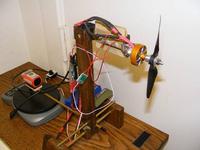As you know, test stand results are no good unless they are accurate and consistent.
To address the first: I recalibrated my stand a few days ago, using suspended weights, and it seems to be exactly where it was two years ago. I used brass balance weights (VERY precise) for readings up to 300g, then I weighed cans of soup etc directly on both my Ohaus Digital Scales, then suspended them from a pulley aligned with the motor thrust line, and read off the thrust [downward force on the digital scale]. All accurate within a few grams at up to 2000g. So far so good.
To address the second: Can I get the same figures each time I test the same prop/motor whatever? I extracted some fairly random numbers for a 10x6 GWS HD and generated this simple graph. If my measurements are consistent, with the same prop, I should get the same thrust reading for a given rpm each time. Right? Well, I reckon this plot - data from 5 motors using the same prop, on 5 different occasions dating back a month or so - suggests a goodly degree of consistency. Not bad for a hobby-grade test rig. |
